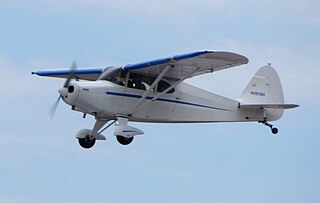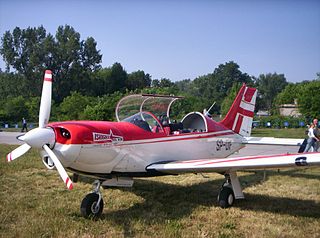
The Piper PA-23, named Apache and later Aztec, is an American four- to six-seat twin-engined light aircraft aimed at the general aviation market. The United States Navy and military forces in other countries also used it in small numbers. Originally designed as the Twin Stinson in the 1950s by the Stinson Aircraft Company, Piper Aircraft manufactured the Apache and a more powerful version, the Aztec, in the United States from the 1950s to the 1980s.

The Piper PA-14 Family Cruiser is an American-built small touring aircraft of the late 1940s.

The Piper PA-24 Comanche is an American single-engine, low-wing, all-metal monoplane of semimonocoque construction with tricycle retractable landing gear and four or six seats. The Comanche was designed and built by Piper Aircraft and first flew on May 24, 1956. Together with the PA-30 and PA-39 Twin Comanches, it made up the core of Piper's lineup until 1972, when the production lines for both aircraft were destroyed in the 1972 Lock Haven flood.

The PA-25 Pawnee is an agricultural aircraft produced by Piper Aircraft between 1959 and 1981. It remains a widely used aircraft in agricultural spraying and is also used as a tow plane, or tug, for launching gliders or for towing banners. In 1988, the design rights and support responsibility were sold to Latino Americana de Aviación of Argentina.

The Piper PA-30 Twin Comanche is an American twin-engined cabin monoplane designed and built by Piper Aircraft. It was a twin-engined development of the PA-24 Comanche single-engined aircraft. A variant with counter-rotating propellers was designated the Piper PA-39 Twin Comanche C/R.

The Piper PA-34 Seneca is a twin-engined light aircraft, produced in the United States by Piper Aircraft. It has been in non-continuous production since 1971. The Seneca is primarily used for personal and business flying.

The Piper PA-18 Super Cub is a two-seat, single-engine monoplane. Introduced in 1949 by Piper Aircraft, it was developed from the PA-11 Cub Special, and traces its lineage back through the J-3 Cub to the Taylor E-2 Cub of the 1930s. In close to 40 years of production, over 10,000 were built. Super Cubs are commonly found in roles such as bush flying, banner towing and glider towing.

The Piper PA-31 Navajo is a family of twin-engined utility aircraft designed and built by Piper Aircraft for small cargo and feeder airlines, and as a corporate aircraft. Production ran from 1967 to 1984. It was license-built in a number of Latin American countries.

The Piper PA-16 Clipper is an extended fuselage model of the PA-15 Vagabond. Both models were designed in 1947 for the same reason – Piper Aircraft found itself in dire financial straits and needed to create new, competitive models using existing parts and tooling. The result was the Vagabond, essentially a side-by-side version of the tandem J-3 Cub credited with saving the company.

The Piper J-5 Cub Cruiser was a larger, more powerful version of the basic Piper J-3 Cub. It was designed just two years after the J-3 Cub, and differed by having a wider fuselage with the pilot sitting in the front seat and two passengers sitting in the rear seat. Equipped with a 75-hp Continental engine the plane's cruising speed was 75 mph. Though officially a three-seater, it would be more accurately described as a "two-and-a-half-seater", as two adults would find themselves quite cramped in the wider rear seat. The Cruiser sold for $1,798 when it was first designed.

PZL M26 Iskierka or M26 Airwolf is a Polish trainer and aerobatic aircraft, designed at WSK PZL-Mielec.

The Piper PA-11 Cub Special is a later-production variant of the J-3 Cub manufactured by Piper Aircraft.

The Bellanca Viking and Super Viking are a series of single-engine, four-seat, high performance, retractable gear aircraft manufactured in the USA during the 1960s and 1970s. The aircraft developed through modifications of classic designs by the aviation pioneer Giuseppe Bellanca. A total of 1,356 Vikings have been produced with most production between 1968 and 1975.

The Piper PA-12 Super Cruiser is an American three-seat, high wing, single-engine conventional landing gear-equipped light aircraft that was produced by Piper Aircraft between 1946-48. The PA-12 was an upgraded and redesignated Piper J-5.

ENAER T-35 Pillán is a Chilean propeller-driven basic trainer aircraft. The student and the instructor sit in tandem. Production ceased in 1991 after 7 years but restarted briefly in 1998.

The Piper PA-36 Pawnee Brave is a 1970s American single-engined, low-wing, propeller-driven agricultural plane built by Piper Aircraft.

The Piper Aerostar is an American twin-engined propeller-driven executive or light transport aircraft, designed by Ted R. Smith. It was originally built by Ted Smith Aircraft Company, which after 1978 became part of the Piper Aircraft Corporation.
The Piper PA-8 Skycycle was a 1940s American single-seat light aircraft designed and built by Piper Aircraft at their Lock Haven, Pennsylvania plant. Towards the end of 1944 Piper announced a number of aircraft it intended to build after the war. One of these was the PWA-8. An aerodynamic test aircraft was built with the name Cub Cycle and it first flew on 27 August 1944 with a small two–cylinder Franklin engine. The Franklin engine was replaced by a four–cylinder Continental A-40-3 of 37 hp (28 kW); the aircraft first flew with the Continental engine on 12 September 1944. The Skycycle was a fabric-covered mid-wing single-engined single-seat monoplane with a tailwheel landing gear. The fuselage was produced using an auxiliary belly fuel tank as used on the F4U Corsair. The Cub Cycle was scrapped and a similar but new aircraft was built with the name Skycycle, which first flew on 29 January 1945 using the same Continental engine as the Cub Cycle. The aircraft was further modified in 1945 with a four-cylinder 55 hp (41 kW) Lycoming O-145-A2 engine and designated the PA-8 Skycycle. No further examples were built.
The Piper PA-29 Papoose was an American single-engined training monoplane designed by Piper, only one was built and the type did not enter production.

The Northwest Ranger was a Canadian bush aircraft that was under development by Northwest Industries (NWI) of Edmonton, Alberta between 1968 and 1972. The aircraft was a type certified design, and intended to be supplied as a complete ready-to-fly-aircraft.


















